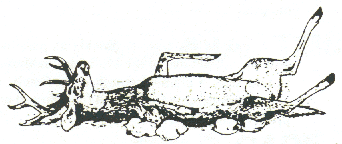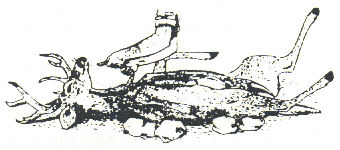Big Game Field Dressing
After Killing Your Game
After you have shot your game, approach it from the rear carefully, making sure it is dead. Validate your tag and attach it to the carcass immediately. Start field dressing it at once with a good, strong bladed knife. Be sure your knife is sharp, maintain a fine edge blade as you work.
If you choose to do so, lay the animal with head downhill and cut it's throat to bleed it. This is not necessary, however, because it will bleed out satisfactorily in the normal process of field dressing.
The following procedure has withstood the test of time by experienced hunters. Many, however, like to vary one or more steps, so the hunter should feel free to innovate to suit the situation.
Be sure to check the Big Game Seasons brochure for instructions concerning evidence of sex and antlers and follow the instructions.




Starting between the hind legs, cut all the way down to the pelvic bone. Then turn your knife blade up, and using your other hand to hold the meat and skin away from the entrails, cut up through the breastbone (brisket), and on up the neck as far as possible. A strong, large-handled knife is needed to best make the cut through the breastbone.
Cut the windpipe in two as far up the neck as possible. Lay your knife down. Grasp the windpipe with both hands and pull hard, downward. The insides will come out all the way down to the midsection.
Now remove the rocks from under the animal and roll the carcass on it's side. Cut the thin layer of meat that is holding the entrails to the ribs, all the way down to the backbone. Then turn the deer over and do the same on the other side.
Lay your knife down again, and using both hands, get a firm grip on the entrails and pull down, hard. All the entrails will come out of the animal.
Lift the animal up by the hind legs and lay a large rock under the rump. This will spread the back legs open. Place your knife against the middle of the pelvis to locate the seam where the bones grow together, and press down hard. If you have a good, stout knife, it may help to twist the blade from side to side to work the blade through the seam. As a last resort, you may have to hit the back of your knife blade to cut through the bone. You can also use a hatchet or saw for large game such as elk. Then you can finish cleaning out the animal.
If a tree is handy and you have a rope, hang the carcass up by the head or antlers for about 20 minutes. This will allow the loose blood to drain out of the body cavity. If no tree is available, turn it upside down in a clean place and let it drain.
You can begin skinning while it is draining. (If it is to be mounted, hang it by the hind legs for skinning.) The skin comes off most easily while the deer is still warm, so it should be skinned within two hours. To remove the skin, cut down the inside of each leg to the middle of the animal, being careful to cut the skin only. Now cut the skin all the way around the neck, as close to the head as possible. Grasp the skin with both hands at the back of the head and pull down hard. Usually the skin will come off down to the front legs. Use your knife to work the skin off the legs and where the skin sticks tightly to the meat. Then pull down on the skin and it will come free.
Take your animal back to camp. Take note that dragging it may get it quite dirty. Keep it clean. (You may opt to quarter or halve it for easier transporting. If you do so, remember to have the tag attached to the largest portion of the carcass.) Hang it up by the hind legs for four or five hours to allow the tiny blood vessels to drain. Keep the carcass in the shade and as cool as possible, and make certain it is free of flies by wrapping it in a game bag or cheesecloth. It is very important that the carcass is allowed to cool throughout within ten to twelve hours. Once it has properly cooled overnight, warm days in the mountains should be no problem so long as the carcass is kept cool in the shade. Without quick and proper cooling, the meat will spoil.

Once you get home it is alright to cut up the meat or you can age it in a refrigerated cooler, or other cool place for a week or ten days before cutting it up. It is advisable to trim all fat from the meat, as wild game fat quickly turns rancid and will affect the meat's flavor. Wrap the cuts well before freezing. Wild game meat is also delicious if cooked and canned, or jerked.

A Note on Elk and Moose
Elk and moose are large, heavy animals and consequently are more difficult to clean and handle. A hand axe, or meat saw is recommended to cut through the pelvis, brisket bones and to divide the carcass down the backbone for quartering. Some nylon cord is helpful to tie the animal down so that the carcass is stable and the big legs don't flop around while you are dressing it out.
It is vital to get these large animals cleaned rapidly and off the ground for cooling as quickly as possible. Get the carcass off the ground so air can circulate, even if up on small limbs, brush or rocks. It is best to quarter the larger animals (even large mule deer), skin them and hang the sections in meat sacks. Small hoists are ideal for this.
Antelope, Goat and Sheep
Antelope are smaller than most deer, usually weighing less then 100 pounds. They are easily cleaned in the field and should be skinned to aid cooling. Where they are hunted, trees are usually scarce, so provide the carcass shelter from the sun's heat.
Goat meat is good to eat if the hunter is very careful to give the meat proper care. Bighorn sheep is rated excellent as far as wild game meat goes. These animals, of course, should be cleaned and cooled promptly.
If you must travel in warm weather, place the carcass in the vehicle early in the morning while it is yet cool and cover it with canvas and sleeping bags to insulate and keep out the heat. Be certain the meat does not get warm on the trip.
Remember - when properly cared for, wild game meat is a special treat for any table and is very nutritious because it is high in protein content.
Top of page
